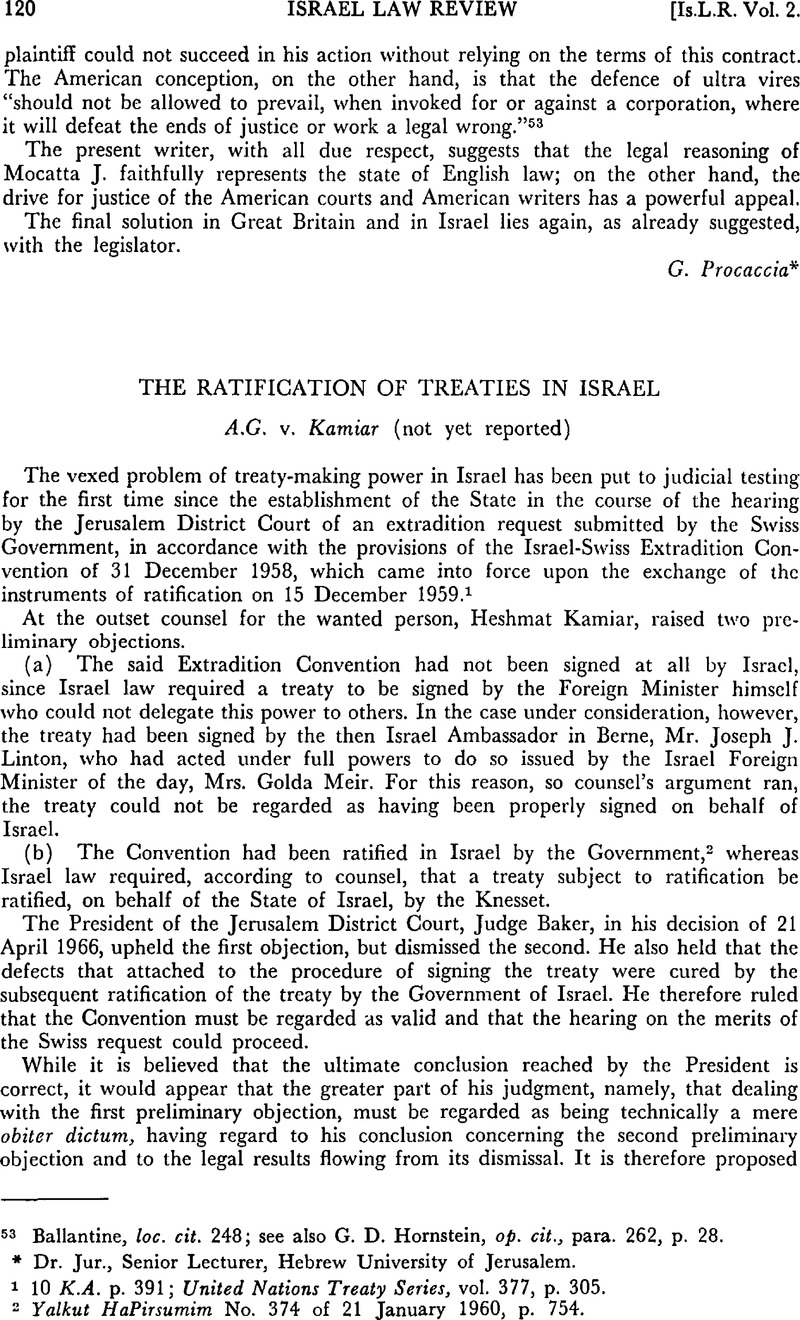Article contents
The Ratification of Treaties in Israel
Published online by Cambridge University Press: 12 February 2016
Abstract

- Type
- Cases
- Information
- Copyright
- Copyright © Cambridge University Press and The Faculty of Law, The Hebrew University of Jerusalem 1967
References
1 10 K.A. p. 391; United Nations Treaty Series, vol. 377, p. 305.
2 Yalkut HaPirsumim No. 374 of 21 January 1960, p. 754.
3 United Nations Legislative Series, Laws and Practices Concerning the Conclusion of Treaties, New York, 1953Google Scholar, ST/LEG/SER.B/3 (hereinafter referred to as “Conclusion of Treaties”) p. 67. The Israel Government's Memorandum was in response to the Secretary-General's circular letter of January 1951, in which he had requested information relative to the various national laws and practices in the matter of conclusion of treaties.
4 Ibid.
5 1 L.S.I. 7, 9.
6 Conclusion of Treaties, p. 68.
7 Ibid., p. 69.
8 Ibid., p. 120. (Statement prepared by the U.N. Secretariat, as approved by the British Foreign Office).
9 Ibid., pp. 68–70. Sec. 46 of the Palestine Order-in-Council, 1922, provides that, subject to the existing statutory law of Palestine, the substance of English common law and the doctrines of equity shall be in force in Palestine, to the extent that the circumstances of Palestine and its inhabitants and the limits of His Majesty's jurisdiction permit this and subject to such qualification as local circumstances render necessary. (For the full text see Drayton, The Laws of Palestine, vol. III, p. 2580).
10 1 L.S.I. 9–10.
11 Conclusion of Treaties, p. 70.
12 3 L.S.I. 3.
13 Ibid. This provision has since been repealed by sec. 26 of Basic Law: the President of the State, passed by the Knesset on 16 June 1964 (18 L.S.I. 111, 115). It has been reproduced, however, almost word for word, in sec. 11(a)(5) of the said Basic Law. The juridical significance of these legislative developments is discussed further in this paper. As to the provision contained in sec. 6 of the Transition Law, it has been rightly observed that it is “somewhat puzzling and its terminology unfortunate.” (Blix, Treaty-Making Power, 1960, p. 199).
14 Conclusion of Treaties, pp. 70–71. The Government approach finds support in the fact that the marginal title of sec. 6 is “Functions of the President.”
15 Divrei HaKnesset, vol. 3, p. 315.
16 Ibid., p. 321.
17 Ibid.
18 Ibid., p. 345.
19 Lapidoth (Eschelbacher), La conclusion des traités internationaux en Israël, 1962, p. 73.
20 Ibid., p. 81. Italics in original.
21 Ibid., p. 82. For a general survey of the problem of treaty-making competence in Israel up to 1960, see also Blix, op. cit., pp. 196–203.
22 Divrei HaKnesset, vol. 35, p. 782.
23 Ibid., p. 772.
24 Ibid.
25 Ibid., p. 773. The Minister did not, however, specify what treaties he regarded as falling within these categories and by which yardsticks he proposed to distinguish between “important” and “less important” treaties.
26 Ibid., p. 774.
27 Ibid., p. 2033.
28 Ibid., p. 2034.
29 Ibid.
30 Ibid.
31 Ibid., p. 2035. This, no doubt, would have been a departure from the normal course in which signature precedes ratification.
32 Ibid., pp. 2037–2038.
33 The translation given by us here does not correspond to the authorized English version (18 L.S.I. 112) which reads:
“The President of the State … shall sign such conventions with foreign states as have been ratified by the Knesset.” The departure of the English text of the Basic Law of 1964 from the English text of the 1949 Transition Law is not warranted by a corresponding change in the original Hebrew. It represents rather an attempt by the translator to read into the former the interpretation given to it by the Government and thus clearly goes beyond the original Hebrew text.
34 Ibid., vol. 40, pp. 2048–2051. The Knesset, by 31 votes to 14, refused to place the matter on its agenda.
35 Ibid., p. 2050.
36 18 L.S.I. 115.
37 Hansard Commons, vol. 171, p. 2007.
38 McNair, , Law of Treaties, 1961, p. 99Google Scholar.
39 Ibid., p. 190. Italics in original.
40 See supra, notes 25 and 35.
41 U.N.G.A. Resolutions 1991 A and B (XVIII) of 17 December 1963. These amendments were ratified by the Government on 25 April 1965 (Yalkut HaPirsumim No. 1312 of 27 October 1966), and laid before the Knesset on 24 May 1965 (Divrei HaKnesset, vol. 43, p. 28.)
42 It is revealing to contrast the approach of the Government of Israel which claims for itself the right to determine which treaties are to be regarded as “important” for this purpose with the Ponsonby statement on this point: “In the case of important treaties, the Government will, of course, take an opportunity of submitting them to the House for discussion within … [the three weeks] period. But, as the Government cannot take upon itself to decide what may be considered important or unimportant, if there is a formal demand for discussion,… time will be found for the discussion of the Treaty in question.” (Hansard Commons, vol. 171, p. 2007; italics added.)
43 See supra, notes 27–31.
44 See e.g. Lapidoth, , “On the validity of the Israel-Swiss Extradition Convention” (1966) 22 HaPraklit 328, at 341Google Scholar (in Hebrew).
45 Reports of the International Law Commission on the second part of its 17th session and on its 18th session, U.N. Doc. A/6309/Rev.l, p. 26.
46 Ibid., p. 27.
47 Ibid.
48 In the 8th edition of vol. I of Oppenheim-Lauterpacht the passage referred to by Judge Baker may be found at p. 917. (The learned judge refers for some reason to the 5th edition of the book). However, the slight stylistic divergences between the two texts do not affect their material meaning.
- 3
- Cited by




